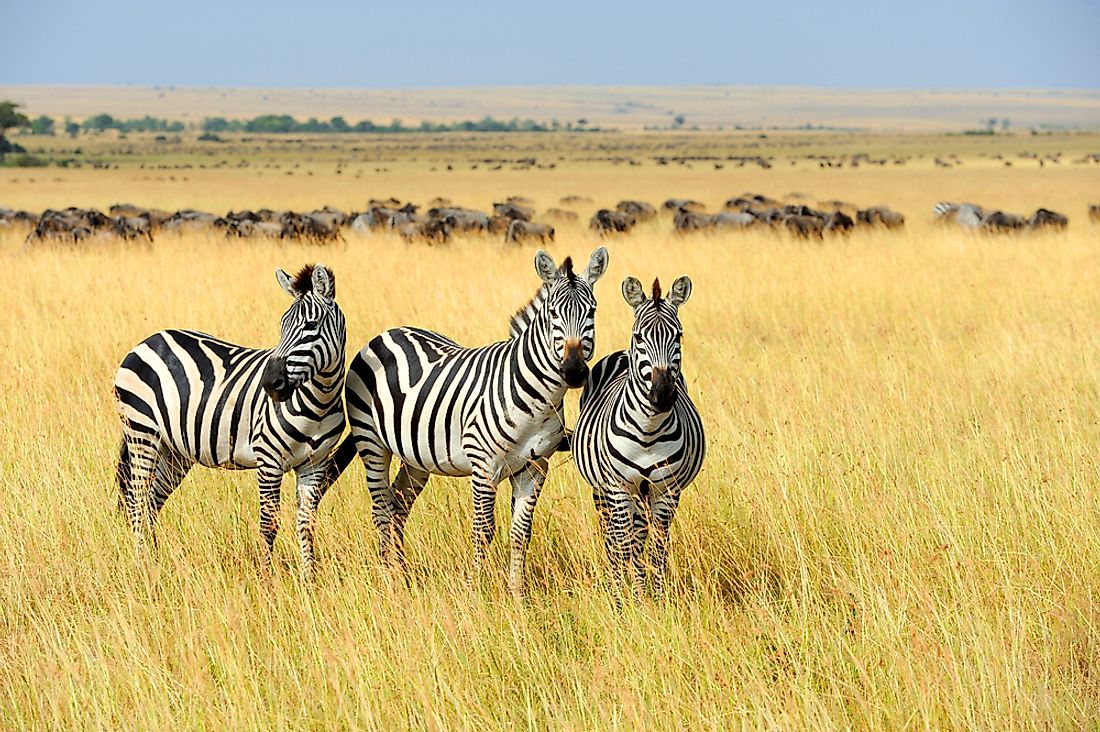Where Do Zebras Live?

Zebras are some of the world’s most distinct animals due to their unique black and white pattern and how much they resemble horses and donkeys. Each zebra has a pattern unique from any other zebra on earth. Zebras comfortably inhabit several areas such as mountains and savannahs depending on the species. Humanity has had wide-ranging interactions with zebras including several attempts to domesticate them. Proponents for their domestication cited the fact that horses had a higher resistance than zebras when it came to African diseases. Most of the attempts were met with failure; therefore, zebras were crossbred with horses and donkeys and their progeny preferred over purebred zebras. The Defenders Of Wildlife estimate that the global zebra population is under 800,000 individuals spread across three species.
Native Habitat of Zebra Species
The three species of zebras and their subspecies live in different countries across Africa. The plains zebra is found in several eastern and southern countries, the mountain zebra is found in southern Africa, and the Grevy's zebra is found in eastern Africa.
Plains Zebras
The plains zebra is a near threatened species and currently have the most significant number of living subspecies totalling six. In the 19th century, one subspecies the quagga, whose habitat was in South Africa, was hunted to extinction. The Burchell's zebra, named after William Burchell, is a subspecies of the plains zebra whose habitat is in southern Africa. Significant numbers are living in Etosha National Park in Namibia and Swaziland. Another subspecies of the plains zebra is Grant's zebra with a range that includes Zambia and the Democratic Republic of Congo. Other nations where the subspecies live include: Somalia, up to the Juba River; Ethiopia, in the nation’s southern territory; Tanzania in the north of the country; and Kenya where they inhabit the state’s eastern territory. The Selous' zebra subspecies is listed as critically endangered of all the plains zebra, which are mostly found in Mozambique. Previously, its habitat covered most of south-eastern Africa. Within the northern territory of Eastern Africa lives another subspecies known as the maneless zebra. The subspecies occupies territory in Uasin Gishu in Kenya, Karamoja in Uganda, and Boma National Park in South Sudan. Another plains zebra subspecies is the Chapman's zebra native to Namibia, Zambia, Botswana, and Angola. The final subspecies of the plains zebra is the Crawshay's zebra with a native habitat extending across four African countries of Mozambique, Malawi, Tanzania, and Zambia.
Mountain Zebra
The mountain zebra is listed as vulnerable and has two subspecies: the Hartmann's mountain zebra and the Cape mountain zebra with the former being listed as vulnerable subspecies. Hartmann’s zebra is known for its agile climbing and their ability to live in arid areas. They are endemic to Angola and Namibia and usually live in small groups of about 7 to 12 individuals. The other subspecies, Cape mountain zebra, are mainly found in South Africa. In the past, it occupied vast tracts of land in the South African Cape Province, but now their population is limited to mountain reserves and national parks within South Africa such as the Mountain Zebra National Park.
Grevy’s Zebra
The third species of zebra is the Grevy’s zebra which is not only the largest zebra species but also the one facing the highest risk of extinction. The species was named in honor of the then French president Jules Grévy by Émile Oustalet. The largest population of Grevy’s zebra are found in Kenya with a few herds living in Ethiopia. Previously the Grevy’s zebra could be found in Djibouti and Somalia but was driven to extinction in those countries.
Conservation of the Zebras
To ensure that human activities do not drive zebras to extinction various organizations and governments work together to ensure that the zebra population is stable. The Kenyan and Ethiopian governments work together to ensure the stability of the Grevy’s zebra population.











